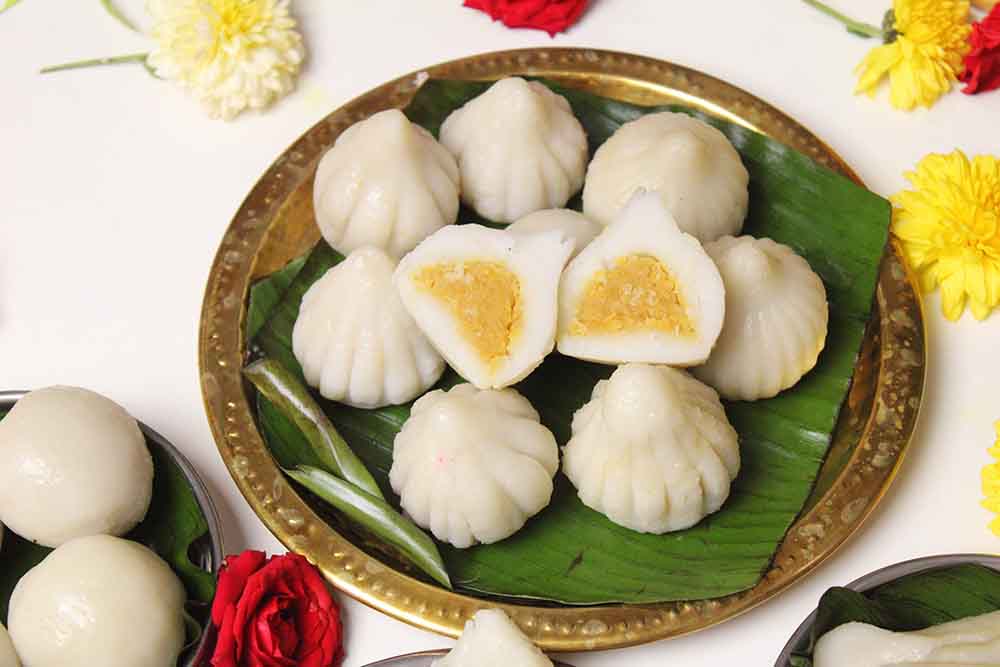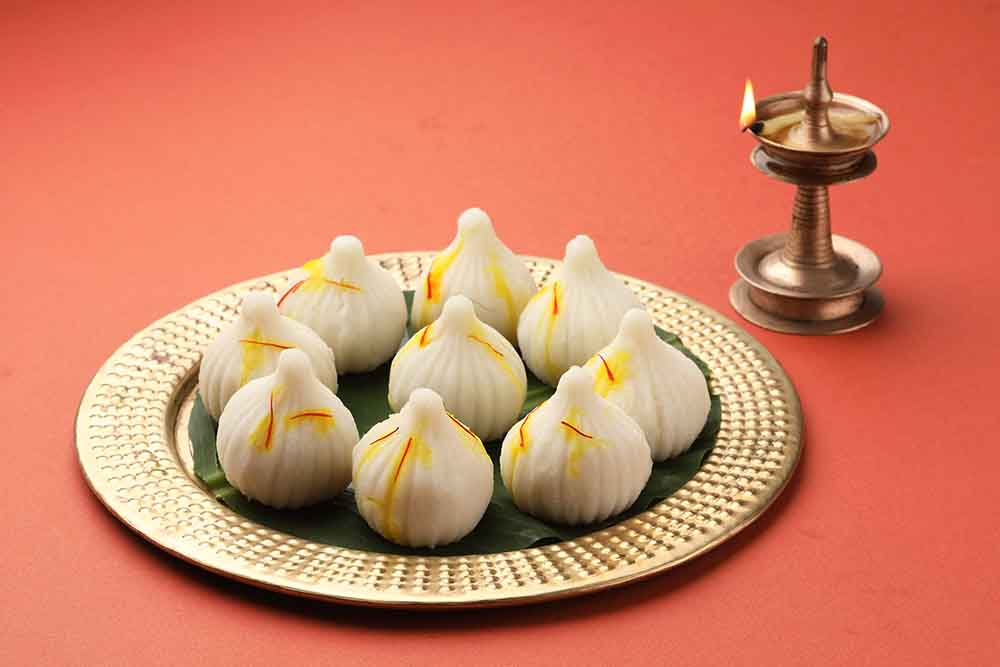Modak is not just a sweet dish; it's a tradition, a symbol of love, and a delight for the taste buds. Whether you're celebrating Ganesh Chaturthi or simply craving something sweet and unique, learning how to make modak is a rewarding experience. In this comprehensive guide, we'll take you through the steps to create these delectable dumplings, with and without a mould.
Overview of Modak
Modak, a revered Indian sweet, holds a special place in Hindu culture, especially during Ganesh Chaturthi, where it is considered Lord Ganesha's favourite treat. These sweet dumplings are made from rice flour dough and filled with a sweet mixture of jaggery, coconut and cardamom. They are steamed to perfection, resulting in a soft, melt-in-the-mouth texture. Modak comes in various shapes and sizes, making them a delightful treat to both the eyes and the palate.
Ingredients Required
To prepare this delightful dessert, you'll need the following ingredients:
For the Dough
• 1 cup rice flour
• 1 cup water
• A pinch of salt
• 1 tsp ghee (clarified butter)
For the Filling
• 1 cup grated fresh coconut
• 1 cup jaggery, grated or chopped
• 1/2 tsp cardamom powder
• A pinch of nutmeg powder (optional)

Prepare the Filling
• In a pan, combine the grated coconut and jaggery over low heat.
• Stir continuously until the jaggery melts and blends with the coconut.
• Add cardamom and nutmeg powder, if using, for extra flavour.
• Cook until the mixture thickens and starts to leave the sides of the pan.
• Allow the filling to cool completely before using it for modak.
Prepare the Dough
• Boil one cup of water with a pinch of salt and ghee in a saucepan.
• Once it boils, reduce the heat and add rice flour.
• Quickly stir to combine, making sure no lumps form.
• Turn off the heat and cover the pan with a lid.
• Allow it to rest for 5 minutes, then transfer it to a plate.
Shape the Modak with Mould
• Grease the modak mould with ghee.
• Take a small portion of the dough and flatten it into a small disc.
• Place a spoonful of the prepared coconut-jaggery filling in the centre.
• Gather the edges of the dough and close it, creating a modak shape using the mould.
• Repeat this process for the remaining dough and filling.
Shape the Modak without Mould
• Take a small portion of the dough and flatten it into a small disc on your palm.
• Place a spoonful of the prepared coconut-jaggery filling in the center.
• Gather the edges of the dough and seal them, shaping it into a modak without using a mould.
• Ensure the modaks are evenly shaped and sealed.
Steam the Modak
• Grease a steamer plate or a colander with ghee.
• Place the modaks on the plate, leaving some space between them.
• Steam them over high heat for 10-12 minutes until they become shiny and translucent.
• Allow them to cool for a few minutes before removing them from the plate.
Tips
• While making the dough, keep the flame low and stir continuously to avoid lumps.
• Ensure the filling has cooled down completely before using it.
• Apply ghee to your hands while shaping the modaks to prevent sticking.
• Steam the modaks immediately after shaping to prevent them from drying out.
• You can garnish modaks with saffron strands or chopped nuts for an extra touch of elegance.

Conclusion
In conclusion, making modak is an art, a tradition, and a delicious journey in itself. Whether you use a mould or shape them by hand, the end result is a sweet treat that's sure to win hearts. Modak isn't just a dessert; it's a symbol of love and devotion, making it perfect for festive occasions like Ganesh Chaturthi. So, roll up your sleeves, gather your ingredients, and embark on this delightful culinary adventure. Whether you're a beginner or an experienced cook, making modak is a joyous celebration in itself.
FAQs
Can I use store-bought rice flour for making modak?
While homemade rice flour is preferred for its freshness, you can use store-bought rice flour as well. Make sure it's of good quality and fine texture.
What can I substitute for jaggery in the filling?
If you don't have jaggery, you can use brown sugar or palm sugar as a substitute. However, the flavour may vary slightly.
Can I make modak ahead of time?
Yes, you can make modak in advance and store them in an airtight container in the refrigerator for up to 2-3 days. Reheat them slightly in a steamer before serving.
How do I prevent my modak from cracking while steaming?
To prevent cracking, make sure the dough is smooth and crack-free when shaping the modak. Additionally, steam them over low to medium heat instead of high heat.
Can I fry modak instead of steaming them?
Traditionally, modak is steamed to maintain its soft texture. However, you can deep fry them if you prefer a crispy version. It is known as ‘fried modak.’
Can I use different fillings for modak?
While the classic coconut-jaggery filling is traditional and beloved, you can experiment with various fillings. Some popular alternatives include dry fruits and nuts, sesame seeds and jaggery or even chocolate and mawa (khoya) for a modern twist.
Is there a specific shape I should make my modak in?
Modaks come in various shapes, from the classic pyramid-like shape to more intricate designs. The shape you choose depends on your preference and creativity. The most important aspect is that it's well-sealed to prevent the filling from spilling out while steaming.
Can I make modak gluten-free?
Yes, you can make gluten-free modak by using gluten-free rice flour. Ensure that all your ingredients, including jaggery and any additional flavorings, are gluten-free as well.
What are some variations of modak that I can try?
Modak is a versatile dessert, and there are several regional variations to explore. Some popular ones include Kozhukattai in South India, Steamed Modak with a twist of pistachio and saffron, and even fried modak for a crispy treat.
How can I make my modak extra special for festive occasions?
To make your modak stand out during festivals, you can enhance their appearance with edible food colors, edible silver or gold foil, or even intricate designs using moulds. This will not only make them visually appealing but also add a festive touch.
Can I make a savoury version of modak?
Absolutely! While modak is typically sweet, you can create a savoury version by replacing the sweet filling with a mixture of spiced vegetables, lentils, or even minced meat, creating a delightful snack or appetiser.
What is the significance of modak in Hindu culture?
Modak holds immense significance in Hindu culture, especially during Ganesh Chaturthi. It is believed to be Lord Ganesha's favorite food, symbolising his love for knowledge and wisdom. Offering modak to Lord Ganesha during this festival is considered auspicious and is believed to bring blessings and prosperity.
Can I freeze modak for long-term storage?
While it's best to consume modak fresh, you can freeze them for longer storage. Place them on a tray, ensuring they don't touch each other, and freeze until solid. Then transfer them to an airtight container or zip-top bag, separating layers with parchment paper to prevent sticking. When ready to enjoy, steam or reheat them directly from the freezer.
What is the best way to reheat leftover modak?
To reheat leftover modak, simply steam them for a few minutes until they become soft and warm. Alternatively, you can microwave them for a short time, but be careful not to overheat, as it can make them dry.
Can I make modak with a different type of rice flour?
While traditionally modak is made with rice flour, you can experiment with other flours like millet, sorghum or even almond flour to create unique flavours and textures. Just remember that the proportions and cooking times may vary with different flours.
Making modak is not just about cooking; it's about creating a cherished tradition and spreading joy. Feel free to get creative with your modak recipes, experimenting with different fillings, shapes, and presentations to make them even more special for your loved ones and festive celebrations. Happy cooking and may your modak-making journey be filled with love and sweetness!